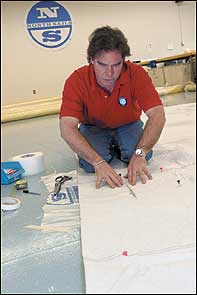Dolph Gabler has been working as the service manager at North Sails Rhode Island for 15 years. In that role, he tends each year to hundreds of sails and all manner of nasty onboard repair jobs.
Yacht captains and delivery crew are rarely interested in aesthetics when they put their sails back together, and Dolphs team of sailmakers have seen sails repaired with such diverse materials as closet dowels and hose clamps, superglue, curtains, and through-bolted plywood. On severely rotted sails, a glued repair is often the best option, since these sails would simply weaken and tear again along any new stitching.
Few cruising sailboats have the space to carry a full complement of spares and supplies for every system, so some overlap in repair kits is required. With that in mind, Dolph ran tests to compare sailmaking adhesives and stitching against other types of adhesives that are generally available in a boats tool bag or at a typical hardware store.
To conduct the tests, Dolph collected dozens of strips of heavy Dacron and Spectra fabrics. Each strip was cut in half and then reconnected with a 1-inch overlap seam using every type of adhesive or adhesive-and-sewing combination that might be available on a 40-foot cruising boat. A professional glue-and-machine-sewn seam was used as a control. The surprising results of the testing are shown in the graph on the next page.
|
|
| |
|

|
| |
| Billy Black|
| |
|
|
| |
| Dolph prepares to repair a sail with a vertical rip using a Spectra patch and 3M 5200 Fast Cure. A plastic sheet below the rip prevents the adhesive from bonding to the work surface. * * *|
| |
|
|
| If the strength of the bond were the only criterion for choosing an adhesive, 3M 5200 Fast Cure would be the undisputed winner. The 5200 Fast Cure seam appeared to be as strong as the 29,000-denier Spectra fabric itself and stronger than any seams built in a sail loft. In the Dacron test, the Dacron fabric broke before the 5200 Fast Cure seam moved.
Of the Spectra samples, we had one fabric break and three samples that held until the test machine reached its maximum load setting and shut itself down. Because its runny enough to penetrate the weave and form a bond with all of the exposed yarn, the 5200 Fast Cure grips even such slippery fabric as Spectra.
The trouble with using 5200 Fast Cure for sail repairs is that it makes a big mess. In no time, the goo spreads to your hands, clothing, and the deck as well as to the sail. To minimize the mess of big repairs, use rubber gloves and a boundary of adhesive transfer tape–commonly called seamstick or basting tape–on the patch or seam. This should help keep the 5200 Fast Cure from oozing out of the repair before it completely cures.
Seamstick is used to hold sail panels together at the seams before sewing. I recommend carrying two types of seamstick, the 3M 950 series (3M part number 4850) and common seamstick with an acrylic carrier (3M part number 3337, also available from other manufacturers). The 950 series (also sold under the name Super Seamstick) grips better than the common seamstick, but the 950 will become gooey and hard to work with after being stored in a hot environment. Consider storing your 950 supply in a resealable container in the fridge. Sailrite Enterprises (800-348-2769, www.sailrite. com) is a one-stop source for a variety of sail-repair tools and materials.
To Repair or Not
At some point, a sail just isn’t worth repairing, but where you draw the line can vary. Some sailors routinely nurse their sails beyond a state that a performance cruiser or sailmaker would consider acceptable. If you decide to keep your sail past its practical life, you’ll have to accept the following conditions:
l Youll need to throttle back at all times. Your trimming decisions will be based on minimizing pressure on the sail, not maximizing speed.
l Youll have to deal with the anxiety of potential failure on all offshore passages.
l Youll compromise your ability to handle adverse weather conditions.
l Your suit of sails will become increasingly ugly.
Vertical-Rip Repair
When a sail gets old and sun-rotted (see “Assessing and Preventing UV Damage,” page 66), the warp threads, the secondary yarns that run perpendicular to the leech or luff, are often the first to give up. So whether the sail is made from laminated fabric or Dacron, rips typically will run parallel to the leech or luff. Laminated sails tend to be more prone to vertical rips because they use secondary yarns even smaller than those used in woven Dacron sails. The laminated sail has a system of secondary yarns on both sides, but since they’re smaller, they cook more quickly.
The sail in the photos on page 74 ripped vertically at the batten pocket. The captions describe the simple repair using a Spectra patch–which Dolph prefers–and 5200 Fast Cure. The result isnt pretty, but its effective: A sail that was condemned to the dumpster is ready to log another season of sailing.
Dan Neri works for North Sails in Newport, Rhode Island. This article is adapted from his book, The Complete Guide to Sail Care & Repair, available from SetSail.com (www.Set Sail.com/Sails).








